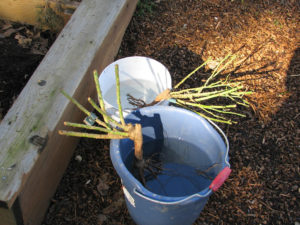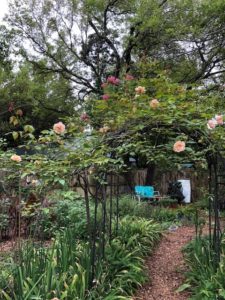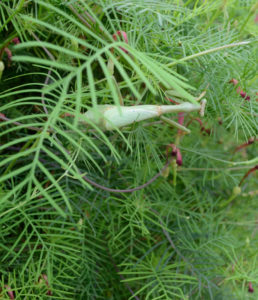Maintaining Roses is Easy
Maintaining roses is one of the easiest things to do in the garden. The trick is to select roses that do well in our climate, plant them at the right time, and give them enough light.
Best Time to Plant Roses

Give your bare root roses a good soak before planting them in the ground.
Most container roses, especially Earth-Kind® or antique, can go into the ground most anytime as long as they have supplemental irrigation. But the best times to plant roses in the Austin area are early fall through early spring. Roses need to establish roots before summer heat. Try to choose mild weather with a chance of rain showers to give the rose it’s best chance to survive and thrive.
Plant bare root roses, those that aren’t in a container, before the bud breaks appear. Depending on the weather, this is usually on or before February 14th. In an especially mild winter, it may be early January. The same rules apply to transplanting an established rose. Plant as early as weather allows so the roots have time to develop in time to survive summer heat.
Where to Plant?

Roses need light to bloom. These Rev d’Or are in very bright dappled shade.
Roses need soil in order to grow sturdy canes and bloom prolifically. They also prefer at least four hours of sunlight or very light, dappled shade. Raised beds or berms are perfect for the Central Texas area as much of our soil is either thin or heavy clay. Be sure to have your soil tested. Most rose-growing advice includes the use of phosphorous fertilizers – which may be a horrible suggestion for the Austin area. Most of our soil already has excess phosphorous, which greatly inhibits iron and other micronutrient uptake. A soil test will tell you what you need for your specific location. No matter what, adding some compost and light mulch on top of the soil after planting and each subsequent year can really get your roses blooming.
Stay on Top of Weeding
Now that you’ve planted the roses, what needs to happen next? You’ll need to weed here and there to keep your roses from becoming smothered or having their light and air supply cut off. They need their space especially to keep air circulating through their branches. After weeding, watering is a good way to keep in balance. And, please remember, one shouldn’t be using a weed eater anywhere near rose bushes. No explanation needed!
How Much Water?
Many roses are fairly drought tolerant, but to perform their best and stay healthy, you’ll need to do some watering. Rainwater is always the best and even contains some nitrogen (from the electrical activity of lightening), but roses will take any kind when needed, just know they do not appreciate constantly wet feet.
Watering their foliage to blast off pests such as aphids and spider mites periodically is great, but make sure it is early in the day and leaves are not staying wet overnight as this is how the blackspot spores become established. Normally root watering, like drip irrigation, is best as it does not leave the foliage damp.
Know the Pests

Know your insects. This Stagmomantis sp. (Mantodea: Mantidae) is one of the good bugs.
In checking over your roses and seeing bugs, remember while there are bad bugs, there are also good ones. Arm yourself with as much knowledge as possible to identify each kind and then plan accordingly. Doing an internet search or having a good reference book or two on bugs is always prudent and a good practice. This site by Texas A&M Entomology is a good place to bookmark.
Additional Resources
Best Roses for Austin and Travis County
Solving the Mystery of Pruning Roses by Dr. Douglas Welsh
Old Roses by Dr. William Welch
The Organic Rose Garden by Liz Druitt, Taylor Trade Publishing (April 1, 1996)
Good Bugs for Your Garden by Allison Starcher, Algonquin Books (January 5, 1995)
Plant Problems and Maintenance
Heirloom Gardening in the South by William C. Welch and Greg Grant
February Gardening Checklist for Austin and Central Texas

Carolyn Williams and her husband live and garden west of Austin in the land of limestone and caliche. This will be her 21st year as a member of Travis County Master Gardeners Association, where she has held several offices including two years as President. Carolyn has chaired numerous committees , writes articles for the TCMGA Compost Bin, gives talks to local clubs and organizations, and is a certified Landscape Designer who always enjoys discovering the beauty and rhythms of her own garden.

